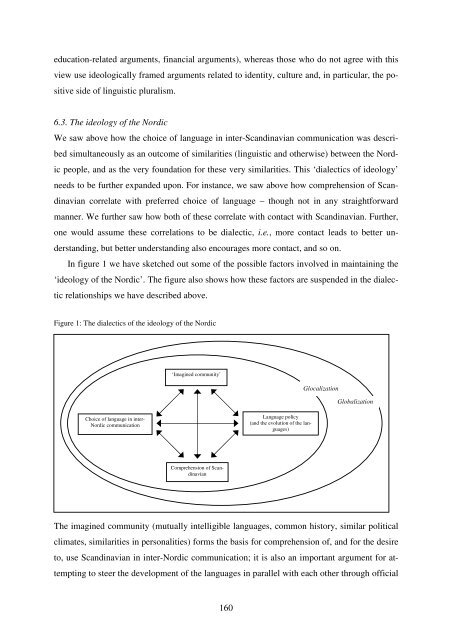Hør dog hvad de siger - Note-to-Self: Trials & Errors
Hør dog hvad de siger - Note-to-Self: Trials & Errors
Hør dog hvad de siger - Note-to-Self: Trials & Errors
You also want an ePaper? Increase the reach of your titles
YUMPU automatically turns print PDFs into web optimized ePapers that Google loves.
education-related arguments, financial arguments), whereas those who do not agree with this<br />
view use i<strong>de</strong>ologically framed arguments related <strong>to</strong> i<strong>de</strong>ntity, culture and, in particular, the po-<br />
sitive si<strong>de</strong> of linguistic pluralism.<br />
6.3. The i<strong>de</strong>ology of the Nordic<br />
We saw above how the choice of language in inter-Scandinavian communication was <strong>de</strong>scri-<br />
bed simultaneously as an outcome of similarities (linguistic and otherwise) between the Nord-<br />
ic people, and as the very foundation for these very similarities. This ‘dialectics of i<strong>de</strong>ology’<br />
needs <strong>to</strong> be further expan<strong>de</strong>d upon. For instance, we saw above how comprehension of Scan-<br />
dinavian correlate with preferred choice of language – though not in any straightforward<br />
manner. We further saw how both of these correlate with contact with Scandinavian. Further,<br />
one would assume these correlations <strong>to</strong> be dialectic, i.e., more contact leads <strong>to</strong> better un-<br />
<strong>de</strong>rstanding, but better un<strong>de</strong>rstanding also encourages more contact, and so on.<br />
In figure 1 we have sketched out some of the possible fac<strong>to</strong>rs involved in maintaining the<br />
‘i<strong>de</strong>ology of the Nordic’. The figure also shows how these fac<strong>to</strong>rs are suspen<strong>de</strong>d in the dialec-<br />
tic relationships we have <strong>de</strong>scribed above.<br />
Figure 1: The dialectics of the i<strong>de</strong>ology of the Nordic<br />
Choice of language in inter-<br />
Nordic communication<br />
‘Imagined community’<br />
Comprehension of Scandinavian<br />
The imagined community (mutually intelligible languages, common his<strong>to</strong>ry, similar political<br />
climates, similarities in personalities) forms the basis for comprehension of, and for the <strong>de</strong>sire<br />
<strong>to</strong>, use Scandinavian in inter-Nordic communication; it is also an important argument for at-<br />
tempting <strong>to</strong> steer the <strong>de</strong>velopment of the languages in parallel with each other through official<br />
160<br />
Language policy<br />
(and the evolution of the languages)<br />
Glocalization<br />
Globalization



